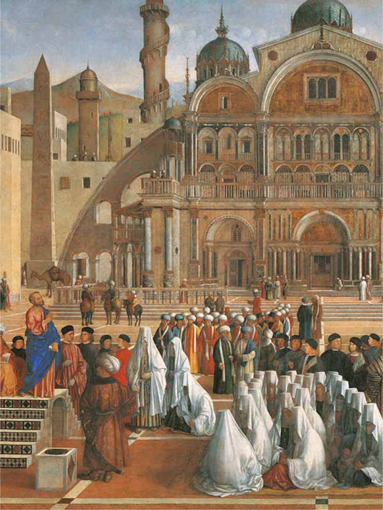The importance of charisma as a quality for today’s leaders is indicated by the fact that the definitions of charisma and leadership overlap. Charis ma automatically comes with a leadership position. However, charisma is not the most important trait of a leader. Charismatic individuals in leadership positions can bring discredit upon themselves if they lack more important qualities. If all other leadership qualities are given, charisma can be an advantage.
Etymologically charisma comes from a Greek word that translates to grace. The dictionary employs several words to define grace. These include elegance, politeness of manner and goodwill. Charis ma is defined as a compelling attractiveness or charm that can inspire devotion in others.[1] Leadership is defined as the ability to channel the actions of a group of people. This can be done through formal authority, logic, or through interpersonal qualities as embodied in charisma. By this interpretation, it can be considered a subset of leadership. However, it is not an inseparable part since leadership can be accomplished by other means. Vladimir Putin is a leader with whom both poise and authority can be associated. In 2014, Putin did not achieve the reintegration of Crimea with Russia through his charms. His actions in Ukraine proved that authority alone can be sufficient for effective leadership. Therefore, while charisma can be a part of leadership, it is not necessary.
Charisma is attributed to all great leaders by default. A prime example is Gandhi. He was a simple and soft-spoken man who wore merely a loincloth around his waist. Gandhi is remembered today as a charismatic leader merely because he was honored as a leader. Stalin did not invade Poland with any compelling attractiveness of character. Hitler did not create the holocaust using personal charm. Unlike Churchill and Mandela, Stalin and Hitler were effective simply by the skilful use of their power. Yet, they are considered charismatic leaders. It is difficult to find examples of great leaders that did not possess any aura because followers automatically attribute it to a person of leadership. This shows that the significance of a charming personality can sometimes be more sentimental than practical.
Charis ma is the not the most important quality of a leader. It is possible to fail as a leader, while possessing charisma, for want of other characteristics. Integrity and vision are far more vital. Dick Fuld, the persuasive and charismatic CEO of Lehman Brothers led one of the largest financial services companies in the world to bankruptcy.[2],[3] On the other hand Microsoft is an excellent example of how charisma can help speed-up the success of a strongly authoritarian leader such as Bill Gates. The two contrasting examples show that charisma may be likened to efficiency. It can help a good leader become great or get a poor leader to ruin faster. Clearly, charisma is not the all-important component of being a leader.
Charisma can help all kinds of leaders. Every leadership position requires persuading, influencing and eliciting obedience. Charisma can help a leader achieve these ends through enthusiasm, goodwill and positive emotions, rather than relying purely on logic.[4] Charisma is ethos and pathos. Charismatic leaders are eloquent communicators and skilled orators. They engage with their audience not only with arguments but also with emotions, values and passion. Charisma persuades followers to buy into a leader’s vision. The workplace has evolved with technological development and globalization. Employees have greater choice and access. Employers need to be more flexible and transparent. Diversity is a fact. Employees need to share the leadership vision in order to have a sense of fulfillment. In today’s world personal magnetism is more important for industry leaders than ever. All other qualities being equal, a charismatic leader can be more effective than one who lacks this quality.
Charis ma can help a leader succeed, but is not a substitute for leadership qualities. Leadership is influence. Charisma is one way to achieve influence, but certainly not the only way. People who are not in leadership positions can also have charis ma; even children can. There are ample examples of leaders who had charisma and failed due to other shortcomings. There are also examples where leaders succeeded without charis ma. To influence people, bold speeches are unnecessary. Followers can be inspired by a leader’s credibility, moral conviction, strength of character and focus on goals. These are valued qualities of leaders such as Richard Branson and Elon Musk. Charis ma is not essential for leaders and it certainly cannot stand on its own. However, charisma is great to have.
[1] Oxford Dictionaries | English. (2016). charis ma – definition of charisma in English | Oxford Dictionaries. [online] Available at: https://en.oxforddictionaries.com/definition/charisma [Accessed 20 Dec. 2016].
[2] Huffington Post India. (2016). Dick Fuld, Disgraced Former CEO Of Lehman Brothers, Makes Public Comeback. [online] Available at: http://www.huffingtonpost.in/entry/dick-fuld-lehman_n_7462196 [Accessed 20 Dec. 2016].
[3] Telegraph.co.uk. (2016). The collapse of Lehman Brothers.
Available at: http://www.telegraph.co.uk/finance/financialcrisis/6173145/The-collapse-of-Lehman-Brothers.html [Accessed 20 Dec. 2016].
[4] Antonakis, J. (2016). Using the power of charis ma for better leadership. [online] the Guardian. Available at: https://www.theguardian.com/sustainable-business/blog/learning-charisma-sustainability-leaders [Accessed 20 Dec. 2016].










